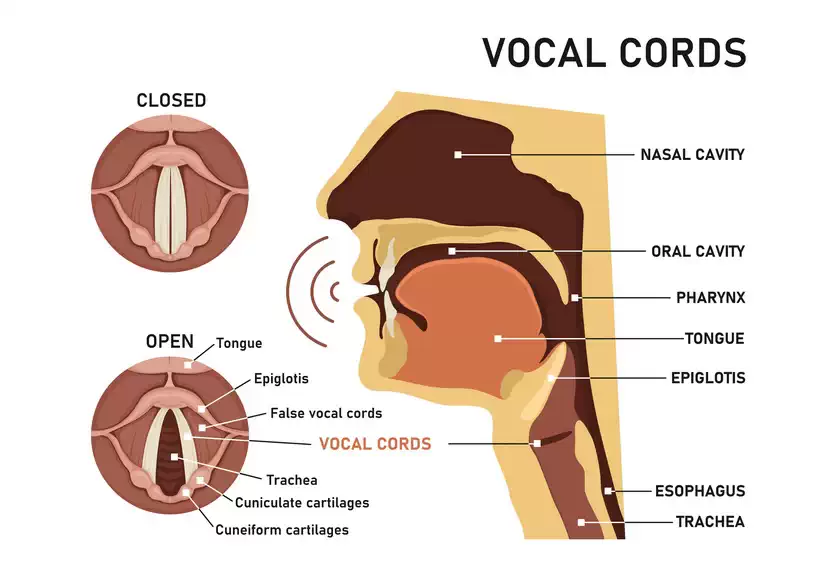Whether you write your own music or prefer to perform other songs, you probably look forward to any opportunity to improve your singing. And if you want to expand your range upward, you’ll need to develop your head voice and falsetto. However, if you’re like most singers, you might not know the difference between the two. Let’s take a look at falsetto vs head voice!
Falsetto vs Head Voice: Telling the Difference
1. What Are the Different Vocal Registers?

In order to understand the difference between falsetto and head voice, you’ll need to understand where these two voices fit in with other vocal registers. You’re likely familiar with chest voice and head voice. The chest voice is a register used for lower notes.
It’s the voice usually used for talking and feels like it resonates in your head. The head voice is a register used to sing high notes (or at least higher notes). It feels like it resonates in your head. Many singers prefer to blend elements of both head voice and chest voice to produce mixed voices.
The falsetto register sits above the head voice. There is some overlap, but singers who use falsetto generally use it to reach high notes out of their normal range. Falsetto is often used by tenor voices, though other voice types can use it as well.
And as we’ll see in a moment, the vocal cords behave differently when they produce falsetto. Some singers, mainly women, have a whistle register they can use to hit very high notes.
At the other end of the spectrum is vocal fry, a very low voice that often has a gravelly sound. It’s often used by bass voices or baritone voices in a choir when they can’t quite reach the lowest notes in a piece. If you’re looking for some more information on the different vocal registers and how they work, check out this informative video.
2. How Does Head Voice Work?

There is a difference between head voice and falsetto on an anatomical level, and understanding that difference can help you to confidently practice both. And to understand how vocals work, you should know a little about some of the muscles involved in singing.
The cricothyroid muscles are responsible for tensing and lengthening the vocal cords in order to produce notes with a higher pitch. The cricoarytenoid muscles relax and shorten the vocal cords in order to produce notes with a lower pitch. When you produce a head voice, you rely more on your cricothyroid muscle.
The tense vocal cords work like the strings on a guitar. When they are thin and tight, they produce a higher-pitched sound. So when your cricothyroid is engaged and your vocal cords vibrate, you hear the higher sound of head voice. If you want to learn more about head voice and how to use it with power and control, check out this helpful video.
3. How Does Falsetto Work?
When you sing falsetto, the vibration of your vocal cords and vocal folds is different than it is when singing in a head voice. The vocal cords are lengthened as they are in head voice, enabling you to achieve high notes. However, only the leading edges of the vocal folds vibrate. The rest of the muscles making up the vocal folds are fairly relaxed.
Another of the primary differences between head voice and falsetto has to do with the vocal cord closure. When you produce head voice or chest voice, your vocal cords close completely each time they vibrate, although that closure is very brief.
The vocal folds stay apart in a pure falsetto, allowing more air through. That helps explain the signature light, breathy sound. If you were to watch the vocal cords and vocal folds of someone just learning to sing falsetto, you would see a permanent oval opening to the trachea. As singers work to develop falsetto, the vocal cords may sometimes touch. Because a falsetto voice uses so much air, singers need to have excellent breath control and breath support.
The actual physiology of what happens when you sing falsetto means it’s very difficult to sing in this register with much power. Some trained singers may be able to do so, but using a falsetto (as opposed to head voice) with a good bit of power may lead to vocal damage. If you’re curious to learn more about how falsetto voice works, check out this helpful video!
4. Do Head Voice and Falsetto Sound the Same?

So now you know that your vocal cords work a little differently when producing falsetto voice and head voice. And with most singers, you can hear the difference between the two. Depending on the singer, the two voices could be similar in pitch, but they will often sound different.
Most people would say that singing falsetto results in a thin, light, breathy tone. There usually aren’t appreciable overtones. Since falsetto sits above the head voice, a note sung in falsetto will likely be higher than the other notes being sung.
By contrast, the head voice has a fuller, darker sound. A well-developed head voice will have a somewhat complex tone that’s decidedly different from the more straightforward falsetto. It will sound a lot more resonant than a falsetto, too.
It’s worth noting that most trained singers rarely perform in only head voice or only chest voice. So in many cases, a performer singing in head voice will be using a mixed register that brings in a little bit of chest voice as well.
Some singers have developed a falsetto that is somewhat stronger. If a falsetto has been strengthened and developed over time, it might start to sound closer to the head voice. It might be easier to hear some examples of both falsetto and head voice. This video (above left) offers some examples of famous female singers singing in their head voices. And this video (above right) showcases some famous male singers using falsetto.
5. Do Falsetto and Head Voice Overlap?

You already know that the difference between head voice and falsetto comes largely from the vocal cords and how they behave. But enough people confuse head voice and falsetto that you might start to wonder if their ranges overlap.
The head voice range and the falsetto range do overlap, and most experts estimate that they overlap for approximately one octave. After a certain point, you can only use falsetto to reach a given note. But for the highest octave of your head voice, you likely have the option to sing each note in either head voice or falsetto.
But which one do you use? As we’ll see in a moment, that all depends on the type of tone you want to achieve.
Since many singers use a mix of head voice and chest voice, you might wonder whether you can achieve a kind of mixed register with falsetto and head voice. Unfortunately, you can’t. The reason you can combine head voice and chest voice into a mixed voice is that head voice and chest voice are technically part of one register: the modal register. The modal register just refers to your natural, regular singing voice.
Since the physiology of falsetto is so different, you can’t really “mix” it with a head voice. But you can do exercises and practice with falsetto in order to strengthen it. Doing so can help to strengthen your whole vocal process, and it also can add a little more power to your falsetto. Check out this helpful video if you’d like some advice on strengthening your falsetto.
6. When Should You Use Head Voice?

Now you have a sense of falsetto and head voice and how they sound different. And if you’re trying to incorporate one or both into your singing, you might not be quite sure when to use each one.
Let’s take a look at when to use head voice. If you’re wanting a rich, full sound, using a full-head voice is the way to go. Many singers use a head voice if they’re performing a song that moves from lower notes to higher notes. After all, if you’ve perfected the art of singing in mixed voice, you’ll be able to move seamlessly from chest voice up into head voice.
The head voice is a good choice if your goal is to reach higher pitches while maintaining decent volume. After all, classical sopranos are able to sing in head voice and fill up a theatre with no mic at all! If you want to learn how to seamlessly move from a low note in chest voice to a high note in head voice, check out this helpful tutorial.
7. When Should You Use Falsetto?

While you probably will hear more talk about head voice, singing falsetto definitely has its place, too. You already know that falsetto is great for reaching higher pitches, but there’s some more nuance involved.
Most singers suggest only using falsetto on selected phrases or verses of a song. Part of that reason has to do with energy. When you start singing falsetto, the resulting sound is thin and breathy. That’s because you’re releasing more air than you would in a chest or head voice. Remember that your vocal folds completely touch (at least briefly) when you sing with your head or chest voice. When you sing falsetto, they stay open.
This may not sound like it matters too much. But singing is a physical exercise, and it takes energy and good breath support technique to ensure you have enough breath to sing falsetto correctly.
Another reason most singers don’t use a continuous falsetto is that it just doesn’t seem right in many genres. If a singer keeps their voice artificially high all the time, the experience of listening may start to feel inauthentic.
But sprinkling in some falsetto to underscore a song’s emotion can make a difference. Sam Smith is a great example of a famous singer who uses the right amount of falsetto. In this song, the light, breathy nature of the falsetto adds a sort of vulnerability to the verses. By contrast, the chorus sounds strong and has a much greater impact.
Of course, depending on both the genre of music you perform and your own personal style, you might not want to perform using falsetto at all.
There’s nothing wrong with that! Most vocal instructors and singers would encourage you to become comfortable performing in your head voice and chest voice (and combining them into your mixed voice); if you sing only in your head voice or only in chest voice, you’re limiting yourself. But falsetto is a stylistic choice that simply doesn’t work in all situations.
However, developing your falsetto has some definite benefits, even if it’s only during your practice sessions. Doing so can increase your range in both directions, increase your singing stamina, and help you perfect your breath control.
Ready to Sing Better?
Expanding your vocal range to reach high pitches and sing falsetto takes practice. But if you aren’t practicing the right way, all your hard work could end up causing an injury. That’s where online learning comes in. If you want to develop better breath control, better vocal power, or anything else, an online singing course can help you achieve your vocal goals. Best of all, most sites offer lessons and courses tailored to specific genres so you can dial in the sound you’ve always wanted.
Final Thoughts
Hopefully, you now have a better grasp of falsetto vs head voice. Even if you prefer to sing lower and rely more on your chest voice, developing both the head voice and falsetto can help you practice breath control and get a stronger, more expressive voice.
But what do you think? Do you have any additional insights on falsetto vs head voice? Let us know in the comments, and please don’t forget to like and share if you found this list useful!
